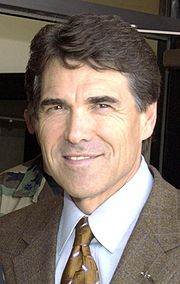Governor of Texas
| Governor of Texas |
|
|---|---|
| Style | The Honorable |
| Residence | Texas Governors Mansion |
| Term length | Four years, no term limits |
| Inaugural holder | James Pinckney Henderson 1846 |
| Formation | Texas Constitution |
| Website | Office of the Governor |
The Governor of Texas is the head of the executive branch of Texas's government and the commander-in-chief of the state's military forces. The governor has the power to either approve or veto bills passed by the Texas Legislature, and to convene the legislature. The governor may grant pardons in cases other than impeachment (but only when recommended by the Board of Pardons and Paroles) or in the case of treason, with permission by the legislature. Compared to the governors of other US states, the Governorship of Texas is often cited as a fairly weak office.[1][2] In some respects it is the Lieutenant Governor of Texas, who presides over the state legislature, who is a more powerful political figure able to exercise greater personal prerogatives. [1][2] The state's first constitution in 1845 established the office of governor, to serve for two years, but no more than four years out of every six (essentially a limit of no more than two consecutive terms).[3]. The 1861 secessionist constitution set the term start date at the first Monday in the November following the election.[4] The 1866 constitution, adopted just after the American Civil War, increased terms to four years, but no more than eight years out of every twelve, and moved the start date to the first Thursday after the organization of the legislature, or "as soon thereafter as practicable."[5] The Reconstruction constitution of 1869 removed the limit on terms,[6] and to this day, Texas is one of 14 states[7] with no gubernatorial term limit. The present constitution of 1876 shortened terms back to two years,[8] but a 1972 amendment increased it back to four years.[9] The Governor is sworn-in on the third Tuesday every four years along with the Lieutenant Governor, so Perry and current Lieutenant Governor David Dewhurst will both begin new terms on January 18, 2011. Despite the lack of term limits, no Texas governor in the 19th or 20th century ever served more than seven and a half consecutive years in office (Allan Shivers) or eight years total service (Bill Clements, in two non-consecutive four-year terms). Current Governor Rick Perry, who took office in December 2000, has now surpassed both these records. If Perry remains in office through the end of his current term, he will become the first Texas governor to serve two consecutive four-year terms. Perry won his party's nomination for a third term in 2010. Shivers, Price Daniel, and John Connally are currently the only three Texas governors to be elected to three terms. Perry won the general election on November 2, 2010 for an unprecedented third four-year term, making him the fourth Texas governor to serve three terms. In case of a vacancy in the office of governor, the lieutenant governor becomes governor.[10] This was added only in a 1999 amendment, prior to which the lieutenant governor only acted as governor, except during the time of the 1861 constitution, which said that the lieutenant governor would be "styled Governor of the State of Texas" in case of vacancy.[11]
See also
- List of Texas Governors and Presidents
- List of Presidents of the Republic of Texas
- List of Lieutenant Governors of Texas
